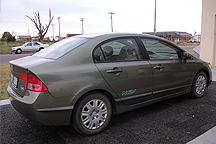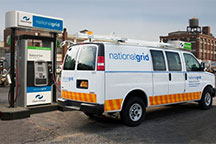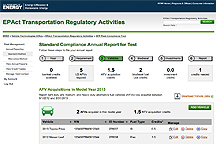EPAct State and Alternative Fuel Provider Fleet Newsletter: Fall 2013
The fall 2013 issue of the EPAct State and Alternative Fuel Provider Fleet Newsletter includes the following articles:
- National Grid Meets EPAct Requirements With Natural Gas Vehicles
- Reporting Tool Helps Fleets Meet EPAct Requirements
- New Fleet Contacts Register Using Updated Process
- Credit Trading Allows Fleets to Meet Requirements
- AFV Acquisitions Allow Fleets to Meet Requirements
- States Join Forces to Encourage Natural Gas Vehicle Market Growth
- Fleets Answer Important Questions Using the AFDC Tools and Resources
National Grid Meets EPAct Requirements With Natural Gas Vehicles
National Grid, an alternative fuel provider operating in Massachusetts, New York, and Rhode Island, has used natural gas vehicles (NGVs) in their fleet for over 40 years. Initially motivated to invest in the technology by energy security, emissions reductions, and cost savings, National Grid has continued to deploy NGVs and natural gas fueling infrastructure to meet its Energy Policy Act (EPAct) requirements through the Alternative Compliance method. As of December 2012, National Grid deployed approximately 425 NGVs and operated 15 public-access compressed natural gas fueling stations in their service area. The success story on National Grid highlights the company's additional successes with alternative fuel and discusses the roll that NGVs and natural gas fueling infrastructure have played in National Grid's compliance with EPAct requirements.
Reporting Tool Helps Fleets Meet EPAct Requirements
The U.S. Department of Energy (DOE) released a new and improved online reporting tool for model year 2012 Standard Compliance. This new tool is more intuitive and dynamic, allowing for a quicker and more straightforward reporting process for fleets. All of the information entered for previous model years has been retained in the new tool.
Last fall, more than 130 fleet representatives attended two webinars to learn how to enter and submit their data through the new tool. A recording of the webinars and a user guide are available to help fleets use the tool. For help with reporting, contact us.
Helpful Hints for the New Reporting Tool
- Use your existing username and password (case sensitive) to log into the new tool.
- Click on the blue question mark icons to find out more about the associated field.
- Red asterisks indicate required fields. If you have data for the other fields, they are valuable for the program but not required.
- Be as accurate as possible about each vehicle make (manufacturer) and model. It is not necessary to provide additional information (e.g., engine size).
- Enter only the neat (B100) biodiesel portion of biodiesel blends. For example, if your fleet used 5,000 gallons of B20 (blend of 20% biodiesel), enter 1,000 gallons of B100.
- The "Save" button on each page allows you to save your work without submitting the report.
- Once you have finished and reviewed your report for completeness and accuracy, select "Submit Report" on the Report tab. Do not select "Submit Report" until you have completed all the information in the report.
- If you need to make changes after submitting the report, contact us to have your report reopened.
New Fleet Contacts Register Using Updated Process
In the new Standard Compliance online reporting tool, each covered fleet should have one point of contact (POC). Each POC needs a user name and password to access annual reports and enter data for their fleet(s).
POC Update "Dos" and "Don'ts"
If your fleet POC changes:
- ✔ Do visit the request new fleet access page or click the "Get Started" button on the reporting tool login page.
- ✔ Do enter your contact information, create login credentials, and click "Save."
- ✔ Do contact us to provide your first and last name, user name, and the fleet(s) that should be linked to your new POC account.
Remember:
- ✖ Do not log in to the tool as the old POC and enter your information.
- ✖ Do not re-enter your fleet information once you have created an account. Once you contact us, your new POC account will be linked to your fleet(s), and the historical reporting information will carry over.
- ✖ Do not create one user name for each fleet. Regardless of how many fleets you have, you need only one user name and password combination to access reports.
- ✖ Do not create a new user name if you forget your password. Instead, click the "Forgot your password?" link on the login page to reset your password.
Credit Trading Allows Fleets to Meet Requirements
Covered fleets that acquire more AFVs than required for compliance can earn credits to be banked or sold to fleets with credit deficiencies. In Model Year 2011, there were 27 transactions between covered state and alternative fuel provider fleets involving the transfer of 468 credits. The credits bulletin board provides a forum for fleets to post information about excess credits for sale, as well as intent to buy credits. The program also posts a list of fleets with excess credits, including fleet contact information. Learn more about the process for banking and trading credits for Standard Compliance.
AFV Acquisitions Allow Fleets to Meet Requirements
Many state and alternative fuel provider fleets choose to satisfy their EPAct requirements by acquiring light-duty vehicles capable of operating on alternative fuel. Different organizations and agencies have varying definitions of an AFV. To meet requirements under the State and Alternative Fuel Provider Fleet Program, a vehicle must operate on an alternative fuel defined by federal law under EPAct. Qualified fuels include:

- 100% methanol
- Denatured ethanol and other alcohols
- Mixtures containing 85% or more of methanol, denatured ethanol, and other alcohols with gasoline or other fuels
- Natural gas (compressed or liquefied)
- Liquefied petroleum gas (propane)
- Electricity (including electricity from solar energy)
- Hydrogen
- Coal-derived liquid fuels
- Fuels (other than alcohol) derived from biological materials, including neat or 100% biodiesel
- Three P-Series blends.
A plug-in electric vehicle (PEV) qualifies as an AFV if it is one of the following:
- Primarily powered by an electric motor
- A dedicated all-electric vehicle
- A dual fueled plug-in hybrid electric vehicle (PHEV) that can complete the U.S. Environmental Protection Agency's (EPA) urban and highway test cycles on electricity alone. The National Highway Traffic Safety Administration makes this determination.
If you have any questions about whether a particular model PHEV qualifies as an AFV, contact the Regulatory Information Line at 202-586-9171 or regulatory.info@nrel.gov.
Some states have enacted laws and adopted regulations defining AFVs differently than EPAct. For instance, recent California legislation, Assembly Bill 2583, changed the state fleet definition of AFVs to include all HEVs and PHEVs. Covered fleets under the State and Alternative Fuel Provider Program must, however, comply with the EPAct AFV definition to receive credit for their acquisitions. For information about currently available AFVs, refer to the Alternative Fuels Data Center (AFDC) tools and resources below.
Learn more about the Standard Compliance method and Credit for Plug-In Hybrid Electric Vehicles.
States Join Forces to Encourage Natural Gas Vehicle Market Growth
To date, 15 governors have signed a memorandum of understanding (MOU) initiated in 2011 to stimulate the production and demand for NGVs. The MOU aims to encourage automakers to offer functional and affordable NGVs, aggregate state vehicle procurement through a joint request for proposals (RFP), boost private investment in natural gas fueling infrastructure, and inspire coordination between state and local agencies. By signing the MOU, the governors have pledged their support and participation.
The National Association of State Procurement Officials (NASPO) coordinated the joint RFP, which the Oklahoma Department of Central Services (DCS) issued on behalf of 22 states. After evaluating more than 100 individual bids from automakers, NASPO and DCS awarded contracts to dealers in all 22 states. These Chrysler, Ford, General Motors, and Honda dealers will deliver NGVs for use in state fleets. Additional awards in the future may mean even more NGV options for fleets.
For more information, including awards by state, see the DCS Statewide Contract for Natural Gas Vehicles solicitation page.
More Resources
- Multi-State MOU on the Purchase of Natural Gas Vehicles
- Memorandum of Understanding
- Solicitation Detail
Fleets Answer Important Questions Using the AFDC Tools and Resources
The Alternative Fuels Data Center (AFDC) provides tools and resources to help fleet managers answer common questions about alternative fuels and other strategies for reducing petroleum use, vehicle emissions, and operating costs.
What are the emissions and cost savings associated with various petroleum-reduction scenarios?
Fleet managers can use the updated Petroleum Reduction Planning Tool to evaluate the benefits associated with alternative fuels and advanced vehicles, along with a variety of efficiency measures, such as idle reduction and fuel economy improvements. Fleets can choose from different strategies to determine the estimated annual petroleum, greenhouse gas (GHG), and fuel cost savings. The tool then provides charts and tables to display the results for each scenario.
Where are the closest alternative fueling stations to my fleet facility and along my fleet's routes?
Using the Alternative Fueling Station Locator, drivers and fleet managers can identify stations that offer electric vehicle charging, E85, biodiesel, natural gas, propane, and hydrogen. Users can sort by fuel type, find all stations near a given location, or map a route with fueling options along the way. The tool also includes the option to download an Excel spreadsheet of the stations that match the search criteria. In addition, a mobile version and an iPhone app are available for smartphone users.
Which alternative fuel options are available for new or replacement vehicles?
The Light-Duty and Heavy-Duty Vehicle Searches include information about alternative fuel cars, light-duty trucks, and heavy-duty vehicles, searchable by manufacturer, fuel type, application, and model year.
Additionally, the Clean Cities 2013 Vehicle Buyer's Guide provides a comprehensive list of model year 2013 light-duty vehicles powered by propane, compressed natural gas, electricity, E85, or biodiesel. The guide also contains valuable model-specific information on engine size, price, fuel economy, and emissions. It is important to note that not all vehicles in the AFDC vehicle searches and the Clean Cities 2013 Vehicle Buyer's Guide qualify under EPAct as AFVs. See the "AFV Acquisitions Allow Fleets to Meet Requirements" article above for more information on which vehicles qualify.
How have other fleets had success or overcome barriers with alternative fuels?
The Case Study Search features a large collection of case studies in both written and video formats. Fleets can search case studies by fuel/technology type and application, or simply by keyword. The tool even includes case studies on state and alternative fuel provider fleets, including Knoxville Utilities Board and National Grid.
In addition, the Clean Cities YouTube Channel features more than 200 success stories, case studies, and training videos.



